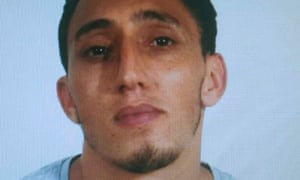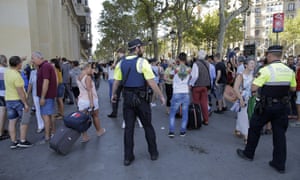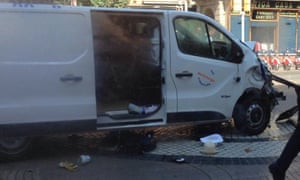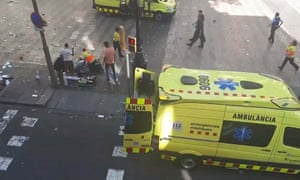
Barcelona van attack – latest updates
Eyewitnesses: driver ‘didn’t care who was in van’s way’
Analysis: attack provides harsh lessons in fight against terror
Thirteen people are dead and at least 50 injured after a van rammed into a crowded street in the heart of Barcelona, in the latest attack where a vehicle was turned into a lethal weapon. Witnesses spoke of panic and seeing people covered in blood, as victims lay dying in Las Ramblas.
Islamic State claimed responsibility for the attack, which took place on Thursday afternoon when a large white Fiat van veered off the road at the top of La Rambla into a crowd of unsuspecting people. Within an hour, Spanish police confirmed they were treating it as a terrorist attack.
Later on Thursday evening, police said two suspected attackers had been arrested. A Catalan police official was quoted by Reuters as saying one of the arrested men was Moroccan and the other was from Melilla, a Spanish enclave in north Africa, and that neither of them was the driver of the van used in the attack.
Police officials have suggested there could be a connection between the Barcelona attack and two explosions earlier in the day in a house in Alcanar, a small town in Tarragona about 100km south of Barcelona, in which one person died and 16 people were injured, including police and firefighters who were investigating the first explosion and were hit by a second blast. The explosions had initially been reported as gas explosions.

The police initially named Driss Oukabir as the renter of the van used in the attack. Later on Thursday evening, however, reports emerged suggesting that Oukabir had handed himself into police after seeing his photograph being circulated online and in the media. He apparently told officers that his identification documents had been stolen before the attack and that he had played no part in it.
Oukabir is understood to be from North Africa but to possess a NIE, the identity document issued to foreigners who are resident in Spain.
The use of vehicles as weapons is now a well-established tactic and has been used in attacks in France, Germany, Sweden and the UK in the past 13 months.
The Spanish prime minister, Mariano Rajoy, cancelled his holiday in Galicia, north-west Spain, to return to Madrid. The Catalan president, Carles Puigdemont, and the mayor of Barcelona, Ada Colau, also cut short their holidays to return to the city, as the regional government announced an emergency meeting.

La Rambla is the boulevard known to all visitors to Barcelona. Leading down from the large, open Plaza de Catalunya, the tree-lined boulevard is a shady release from the beating heat of the square.
At almost any time of the day, the area is full of people buying newspapers, postcards and souvenirs in the kiosks or looking at the flower stalls. Early on Thursday afternoon, with locals mostly away on holiday, a large number of those people were tourists.
At around 5pm, a large white Fiat van veered off the road at the top of the street and drove straight into the crowd milling around near the entrance to the Plaça de Catalunya metro station.
It sped down the central, pedestrian zone of the boulevard towards the port, ploughing its way through the crowd as people fled in panic.
About 500 metres down the boulevard, shortly after the famous Boqueria food market and before the Liceu opera house, the pavement is adorned with a colourful mosaic by artist Joan Miró. It was at here that the van, with its front fender smashed up, came to a halt. The pavement behind it was littered with injured people and 13 people were dead or dying. Several pushchairs could be seen abandoned at the side of the street.

Albert Tort, an off-duty nurse who was one of the first on the scene, said he tried to give an Italian tourist life-saving treatment, but there was nothing he could do. “The pavement was full of bodies,” he told TV3.
Other witnesses spoke of panic as people fled the scene. Jordi Lino, who was on a bus, said: “First I saw people running and then the van. There were injured people in the middle of Las Ramblas.”
Lourdes Porcar told Spanish TV that she saw the van running people over. “It was going very fast, without caring about who was in its way,” she said.
Patrick Tuenter, 20, a law student from Nijmegen, Netherlands, was on the first day of his holiday. He reported “a scene of total chaos”, as he returned from the beach. “People were screaming, there were a lot of wounded people,” he told the Guardian.
At least 600 people were stuck inside restaurants in the area waiting for permission to leave, as police locked down the area and warned people to stay away.
In the panicked moments after the attack, rumours flew around the city, including reports of gunfire in El Corte Inglés department store – later confirmed as untrue by local police, who advised people to follow official sources for updates.
Catalan emergency services advised people to stay away from the area around Plaça de Catalunya. Police asked people to communicate via social media and messaging instead of phone calls, as mobile telephone coverage was saturated.
More than 1,000 people used Facebook volunteering to help the victims, with offers ranging from water to shelter and translation.

A second van – presumed to be a getaway vehicle – had been hired at the same time as the Fiat from the Telefurgo rental company in Sabadell, near Barcelona, was found 80km away in Vic an hour and a half later.
Islamic State claimed responsibility using the group’s Amaq news agency. “The perpetrators of the Barcelona attack are soldiers of the Islamic State and carried out the operation in response to calls for targeting coalition states,” the agency said, referring to a United States-led coalition against the militant group.
Spain suffered what is still Europe’s deadliest jihadi attack in March 2004, when bombs exploded on commuter trains in Madrid, killing 191 people in an attack claimed by al-Qaida-inspired extremists. But until Thursday, Spain had escaped the more recent wave of extremist violence that has struck France, Belgium, Germany and the UK.
Terrorists have turned vehicles into weapons in France, Germany, Sweden and the UK in the past year; most recently when a car was driven into a crowd protesting against a white supremacist rally in Charlottesville, Virginia.
Last July, 86 people were killed in Nice when a 19-ton truck mowed down people on the beach promenade. A Christmas market in Berlin was the scene of a similar atrocity in December, when 12 people were killed by a truck packed with steel.
In April, five people died after a lorry attack in a busy shopping area in central Stockholm. In June, a speeding van hit pedestrians on London Bridge before attackers launched a knife attack in cafes and restaurants at Borough market. Eight people died in the attack, while at least 48 were wounded.
Isis claimed responsibility for the attacks in Nice, Berlin and London Bridge. The Uzbek national suspected of the Swedish lorry attack had expressed sympathy for the group.
According to western intelligence officials, Islamist propaganda has switched its tactics, from calling on people to travel to Syria to join a self-declared caliphate, to urging them to carry out attacks in the countries where they live.
Such vehicle attacks generally require very little planning, and no wider network, leaving little or no opportunity for the authorities to detect and stop them.
As details of the attack emerged, condolences poured in from around the world, with a typically controversial response from Donald Trump. The US president revived an already debunked anecdote about a US general dipping bullets in pig’s blood to fight Islamic militants more than 100 years ago.
The British prime minister, Theresa May, said the UK stood with Spain against terror and Jean-Claude Juncker, the president of the European commission, said: “I hold a special thought for the heroic people who responded by running towards danger to help others and to the security forces who are working to keep the population safe.”Grd / IM )















